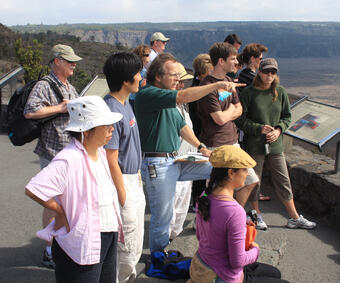Learn More about Hawaiian Volcanic Activity and History
Information about Hawaiian Volcanic Activity and History.

The State of Hawaii is home to six active volcanoes—Mauna Kea, Hualālai, Mauna Loa, and Kīlauea on the Island of Hawai‘i, Haleakalā on the Island of Maui, and Kama‘ehuakanaloa (formerly Lō‘ihi), a submarine volcano south of the Island of Hawai‘i. These volcanoes are classified as "active" because they have erupted within the past 10,000 years and have the potential to erupt again.
Kīlauea erupted nearly non-stop from 1983, when a vent opened on the volcano's East Rift Zone, until 2018. Lava flows from that eruption buried 55 square miles of public and private land, destroyed vast tracts of native forest, about 9 miles of highway, and 215 structures, including homes, a church, and a National Park Service visitor center.
In 2008, a second vent opened at the summit of Kīlauea, and a lava lake resided within Halema‘uma‘u crater until 2018. Halema‘uma‘u was home to nearly continuous lava lakes for over 100 years in the 19th and early 20th centuries.
In 2018, Kīlauea Volcano experienced its largest lower East Rift Zone (LERZ) eruption and caldera collapse in at least 200 years. Lava erupted during this eruption covered 35.5 square kilometers (14 square miles) and partially drained the summit magma system, producing minor explosions and near-daily summit collapse events. The amount of lava erupted in the lower East Rift Zone and the volume of summit collapse are roughly equivalent—about 0.8 cubic kilometers (0.2 cubic miles).
On the evening of December 20, 2020, a fissure eruption began within Halema‘uma‘u crater. Lava filling the crater quickly boiled off the water lake that had formed at the bottom of the crater over the previous year, replacing it with a lava lake. The lava supply dwindled from April to May 2021, and the last surface activity on the lake was observed on May 23. Another eruption began with Halema‘uma‘u crater the afternoon of September 29, 2021, and continued through December 9, 2022. On January 5, 2023, new vents opened in the floor of Halema‘uma‘u crater and that activity is ongoing. See the recent eruption webpage for more information.
Mauna Loa erupted most recently in 2022, and it will erupt again. The 2022 eruption began within Moku‘āweoweo, the summit caldera, and within a day had migrated to the Northeast Rift Zone. Vents on the Northeast Rift Zone erupted for about two weeks, generating lava flows that came to within 1.7 miles (2.8 kilometers) of the Daniel K. Inouye Highway (Saddle Road). HVO continues to closely monitor the volcano.
The State of Hawaii also experiences thousands of earthquakes every year. Most of them are small and closely related to volcanic processes, but hundreds are strong enough to be felt on one or more island, and some are large enough to cause damage. Since 1868, more than 30 magnitude-6.0 or greater earthquakes have rattled Hawaii. The probability of a magnitude-6.5 or higher earthquake striking the Hawaiian Islands in the next 10 years is 50 percent.
An ongoing eruption, volcanic unrest, and potential earthquakes are all reminders of why it's important for Hawaii residents and visitors to be aware of and understand Hawaiian volcanoes and earthquakes.
Annual Events
- Volcano Awareness Month – During the month of January, HVO offers a series of public talks around the Island of Hawai‘i to promote awareness of Hawaiian volcanoes. The schedule of speakers is posted on HVO's website a month or so before the talks begin in January.
You can view some of HVO's past Volcano Awareness Month presentations (2010-2017) through videos posted in Hawai‘i Volcanoes National Park's After Dark in the Park - Video Archives.
- Great Hawai‘i ShakeOut – On the third Thursday of October, Hawaii residents are encouraged to practice "Drop, Cover, and Hold On" during the Great Hawaii ShakeOut, an annual awareness and preparedness event.
It's important to know how to protect yourself and your family when the next strong earthquake hits Hawaii. "Recommended Earthquake Safety Actions" and additional information and helpful resources are posted on the ShakeOut website.



